| Plant Origin & Classification All Materials © Cmassengale |
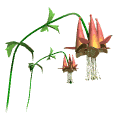 |
Overview of Plants:
- All plants are multicellular & contain chlorophyll inside of chloroplasts
- Plants (also called autotrophs or producers) trap energy from the sun by photosynthesis & store it in organic compounds
- Heterotrophs or consumers get their energy directly or indirectly from plants
- Plants also release oxygen needed by consumers
- All plants are multicellular, eukaryotic organisms that reproduce sexually
- Many medicines are produced by plants
- Plants are very diverse & may be terrestrial or aquatic
- Vary in size from 1 mm in width to more than 328 feet
- May live a few weeks or some over 5000 years
- Kingdom Plantae is divided into 12 phyla or Divisions
- More than 270,000 plant species identified, but new species still unidentified in tropical rain forests
Terrestrial Adaptations:
- Plants probably evolved from green algae
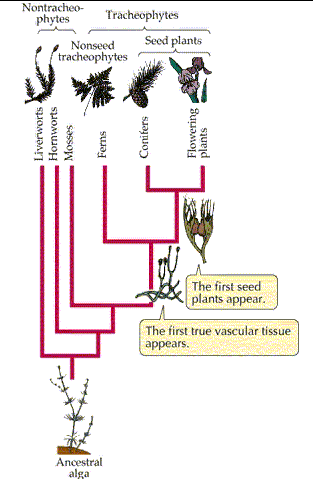
- Both algae & plants have chlorophyll a & b, have cell walls made of cellulose, and store energy as starch
- First land plants had to develop adaptations to scarcity of water & climate changes (air temperature changes more rapidly than water temperature)
- Moving onto land allowed more sunlight, nutrients, & CO2 for photosynthesis
- A support adaptation included a compound called lignin (a hard substance that strengthens cell walls so they can support additional weight)
- The origin of vascular tissue (specialized tissue for carrying food , water, & minerals) was an evolutionary breakthrough in the colonization of land
- Plants with vascular tissue are known as Tracheophytes
- Two types of vascular tissue developed — xylem & phloem
- Xylem carries water & inorganic nutrients from the roots to the stem & leaves
- Phloem carries carbohydrates made by the plants to wherever they’re needed or stored in the plant

Copyright Holt, Rinehart, & Winston
- Some plants formed woody tissue from xylem for extra support, while others kept a flexible, non-woody stem (herbaceous plants)
- Greater amount of water lost by evaporation (transpiration) on land
- A waxy covering or cuticle developed on all plant parts exposed to air which slowed transpiration (water loss)
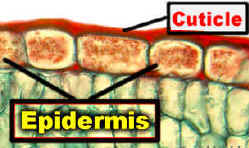
- Gases (carbon dioxide & oxygen) had to be able to move into & out of the plant
- Openings in the cuticle called stomata allowed movement of gases
- Two guard cells on each side of a stoma helped open & close the opening

Copyright Holt, Rinehart, & Winston
- When guard cells lose water & shrink, the stoma closes (prevents water loss in the hotter times of the day)
- When guard cells swell with water, the stoma opens for gas exchange
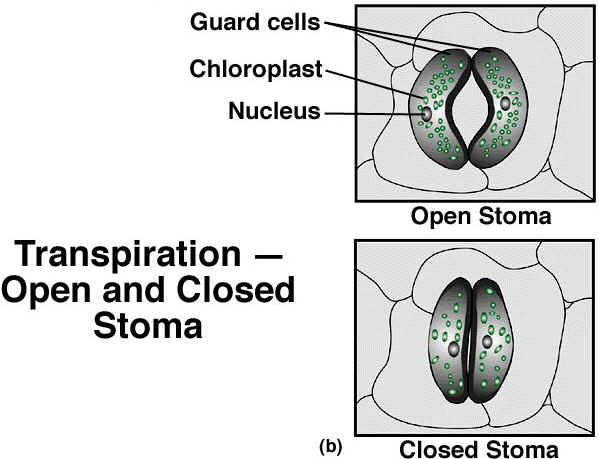
copyright McGraw-Hill
- Other structural adaptations to land included roots for absorption of water and minerals leaves for gas exchange and photosynthesis
Reproductive Adaptations:
- To be successful on land, plants had to develop protective seeds for their embryos with stored food or endoderm
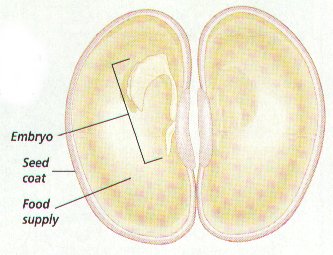
Copyright Holt, Rinehart, & Winston
- Seeds are better at dispersal than spores
Classification of Plants:
- They’re are 12 Divisions of plants divided into two main groups based on the presence of vascular tissue
- Nonvascular plants lack vascular tissue and do not have true roots, stems, or leaves (mosses, liverworts, & hornworts)
- Most plants have vascular tissue with true roots, stems, & leaves, but may or may not produce seeds

Copyright Holt, Rinehart, & Winston
- Ferns, horsetails, & club mosses are seedless vascular plants that reproduce by spores
- Plants that reproduce by seeds are divided into 2 groups — gymnosperms & angiosperms
- Gymnosperms have “naked” seeds usually protected by cones & includes pines, cedars, spruce, fir …
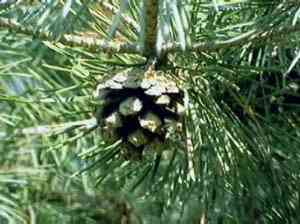
- Angiosperms are flowering plants whose seeds are produced & protected within the fruit

Plant Life Cycles:
- Plants have 2 phases in their life cycle called alternation of generation
- The haploid gametophyte stage produces eggs & sperm, while the diploid sporophyte stage produces spores
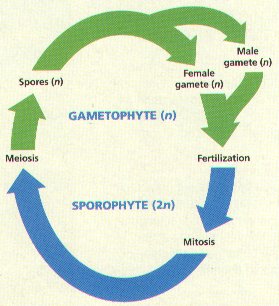
Copyright Holt, Rinehart, & Winston
- Plant gametes are not directly produced by meiosis but rather by mitosis from the haploid multicellular stage
- Meiosis instead produced specialized haploid cells called spores
- These spores are released by most Seedless plants, but are retained by Seed plants
- In nonvascular plants, the Gametophyte stage is dominant (mosses)
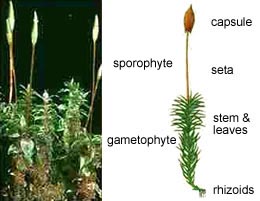
- In vascular plants, the Sporophyte stage is dominant
- Seedless vascular plants usually have a separate, small gametophyte plant
- Sexual reproduction in plants ensures that there will be genetic recombination
Seed-Bearing, Vascular Plants:
- The development of seeds with their protected embryo & stored food supply increased the reproductive success of seed plants
- Seeds remain dormant or inactive when conditions aren’t favorable
- Moisture & warmer temperature cause seeds to germinate or sprout
- Young plant embryos use their endosperm as energy for early growth

- Seeds plants are divided into 2 groups based on the type of seed they produce
Gymnosperms:
- Gymnosperms produce seeds that not protected within an ovary
- The seeds are exposed on the upper surfaces of a spore producing structure (e.g. cone scales in conifers)
- Called “naked” seeds
- Gymnosperms do not produce flowers or fruit
- The four phyla of gymnosperms alive today include the cycads (Cycadophyta), the ginkgo (Gingkophyta), the gnetophytes (Gnetophyta), and the conifers (Coniferophyta)
 |
 |
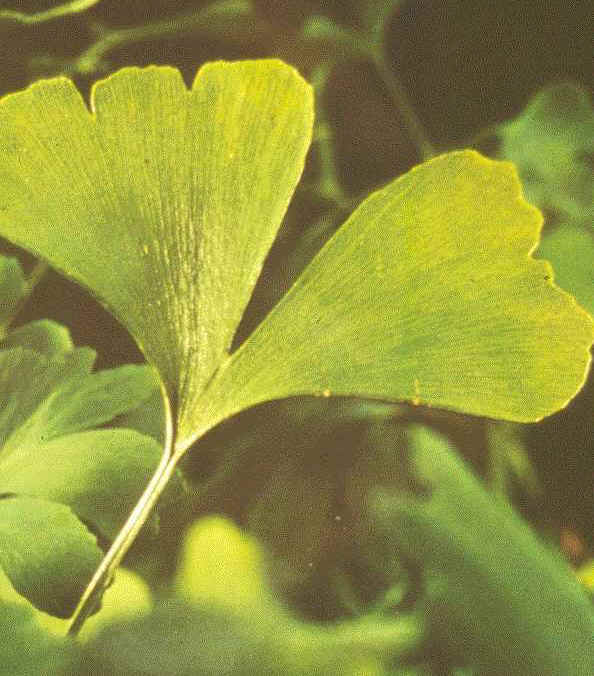 |
 |
| Cycad | Welwitshcia (gnetophyte) |
Gingko | Fir Tree (Conifer) |
- All gymnosperms have vascular tissue to conduct food, water & minerals and produce woody tissue
- Two types of cones are made by gymnosperms — pollen cones & seed cones
- Pollen cones are small & produce pollen containing the male gametophyte which is spread by wind or insects to the female gametophyte
- Seed cones are larger and contain eggs on scales that form seeds when they are fertilized
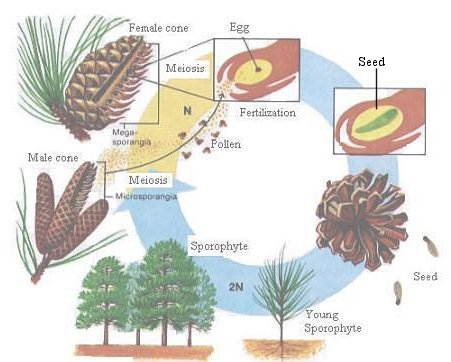
Division Cycadophyta:
- Dominated earth when dinosaurs lived, but only about 100 species are alive today & are endangered
- Most are slow growing, palm-like plants found mostly in tropical areas
- All cycads bear cones, which are made up of seed bearing leaves (sporophylls)
- They have large compound leaves, a short thick trunk, and are dioecious (either male or female plant)
- Cycads bear naked seeds

Zamia (native to Georgia)
Division Gingkophyta:
- Ginkgoes were common in the Mesozoic period, but today only one species of ginkgo remains (Ginkgo biloba)
- Gingko trees have distinctive fan shaped leaves & are dioecious (each tree is either male or female but not both)
- Commonly planted as an ornamental tree
- Gingkoes are not native to North America (they are found growing wild only in China)
- Deciduous tree (loses leaves in fall) with plum-shaped, fleshy seeds with a foul odor
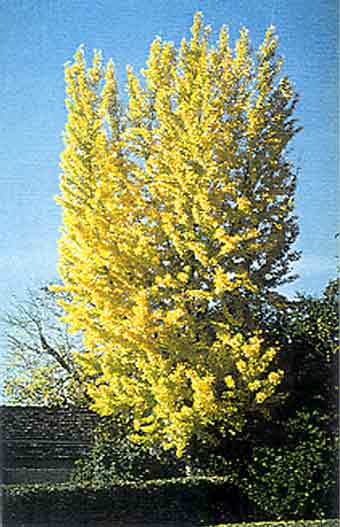
Division Coniferophyta:
- Largest group of gymnosperms
- Called conifers
- Found in abundance in temperate zones
- Include cedars, pines, spruce, fir, juniper, & bald cypress trees
- Their leaves are characteristically needle-like, but may be scale-like
- Usually trees or shrubs
- Evergreens (don’t lose their leaves in the fall)
- Almost all conifers are monoecious, producing both male and female cones on the same tree
- Female cones are larger than male cones with woody scales containing the seeds
 |
 |
| Pollen Cone | Seed Cone |
- Conifers are dependent on the wind for pollination
- Pollen grain has air bladders to help it stay aloft in the wind
- Important source of wood, paper, turpentine, ornamental plants, Christmas trees
- Redwoods and Giant Sequoia trees are the largest living organism on earth
- Bristlecone pines are the oldest living organism on earth
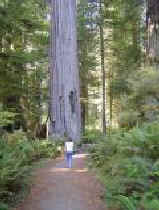 |
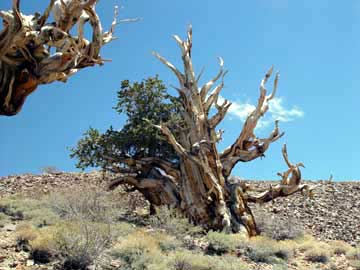 |
| Redwood Tree | Bristlecone pine Tree |
Division Gnetophyta:
- The phylum Gnetophyta consists of 3 genera that are not very closely related
- Ephedra is the largest genus and consists of plants that resemble horsetails & grow in deserts
- Welwitshcia is found only in the desert area of south western Africa and has 2 single, long leaves
 |
 |
| Welwitshcia | Ephedra |
Division Anthophyta (Angiosperms):
- Flowering plants are the most successful group of plants today
- They live in almost all possible habitats
- All flowering plants produce both flowers & fruit

- Fruit is a ripened ovary with its seeds (acorns, apples, dandelion seeds, etc)

- Flowering plants co-evolved with their insect pollinators
- May be herbaceous (grasses & snapdragons or woody (oaks & grape vines)
- Rafflesia, the stinking corpse lily, is the world’s largest flower
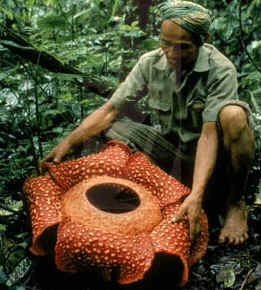
- Flowering plants have diverse lifestyles (Sundew is carnivorous on insects; Spanish moss is an epiphyte living on another host plant; some orchids are saprophytes living on soil fungi)
- Subdivided into 2 classes based on the number of seed leaves or cotyledons in the plant embryo — Monocotyledons & Dicotyledons
- Monocots have a single seed leaf, leaves with parallel venation, vascular tissue scattered in bundles throughout the stem, and flower parts in 3’s or multiples of 3

- Dicots have a 2 seed leaf, leaves with net-veined venation, vascular tissue in rings in the stem, and flower parts in 4’s or 5’s multiples of 4 or 5

- Monocots are usually herbaceous, while dicots often produce wood

